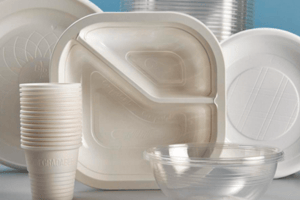Podcast
Questions and Answers
What is a key requirement for the scaffold mentioned in the text?
What is a key requirement for the scaffold mentioned in the text?
- To remain intact indefinitely
- To degrade after tissue formation (correct)
- To break down before tissue formation
- To never degrade
Which type of biomaterial exhibits high mechanical stiffness and low elasticity?
Which type of biomaterial exhibits high mechanical stiffness and low elasticity?
- Synthetic polymers
- Biopolymers
- Natural polymers
- Ceramics (correct)
Which biomaterial is known for its controlled degradation characteristics and tailored architecture?
Which biomaterial is known for its controlled degradation characteristics and tailored architecture?
- Synthetic polymers (correct)
- Natural polymers
- Biopolymers
- Ceramics
Which biomaterial type allows host cells to produce their own extracellular matrix?
Which biomaterial type allows host cells to produce their own extracellular matrix?
Which biomaterial type is often used in bone regeneration applications?
Which biomaterial type is often used in bone regeneration applications?
Which type of biomaterial is considered to be biologically active in the context of scaffolds?
Which type of biomaterial is considered to be biologically active in the context of scaffolds?
Which type of stem cell converts to osteoblasts in support of new bone formation?
Which type of stem cell converts to osteoblasts in support of new bone formation?
What is the main function of platelets in bone marrow concentrate (BMC) used for tissue engineering applications?
What is the main function of platelets in bone marrow concentrate (BMC) used for tissue engineering applications?
Which type of cell is a rich source of regenerative cells needed for bone formation and angiogenesis in human-derived bone marrow concentrate (BMC)?
Which type of cell is a rich source of regenerative cells needed for bone formation and angiogenesis in human-derived bone marrow concentrate (BMC)?
What is the product of a lipoaspirate obtained from liposuction of excess adipose tissue?
What is the product of a lipoaspirate obtained from liposuction of excess adipose tissue?
What role do lymphocytes play in bone marrow concentrate (BMC) used for tissue engineering applications?
What role do lymphocytes play in bone marrow concentrate (BMC) used for tissue engineering applications?
Which type of cell orchestrates bone formation in the context of bone marrow concentrate (BMC)?
Which type of cell orchestrates bone formation in the context of bone marrow concentrate (BMC)?
What is a key challenge facing the field of organ transplantation?
What is a key challenge facing the field of organ transplantation?
Why is biocompatibility important in the context of bioimplants?
Why is biocompatibility important in the context of bioimplants?
What is one bioengineering technique mentioned in the text for improving the functional maturation of organoids?
What is one bioengineering technique mentioned in the text for improving the functional maturation of organoids?
What is a primary focus when developing functional biomaterials for tissue engineering?
What is a primary focus when developing functional biomaterials for tissue engineering?
What are some examples of advanced biomaterials mentioned in the text?
What are some examples of advanced biomaterials mentioned in the text?
How does microfluidic chip technology contribute to organoid development according to the text?
How does microfluidic chip technology contribute to organoid development according to the text?
Why is tissue engineering considered a window of opportunity for supplying organ substitutes?
Why is tissue engineering considered a window of opportunity for supplying organ substitutes?
What is the role of bioreactors in organoid development as described in the text?
What is the role of bioreactors in organoid development as described in the text?
How do functional hydrogels play a role in tissue engineering according to the text?
How do functional hydrogels play a role in tissue engineering according to the text?
How can co-culture systems enhance the development of organoids?
How can co-culture systems enhance the development of organoids?
Which type of cell types are mentioned to be part of co-culture systems to boost organoid development in the text?
Which type of cell types are mentioned to be part of co-culture systems to boost organoid development in the text?
What is one way physiological stimulation is indicated to contribute to developing in vitro organoid systems?
What is one way physiological stimulation is indicated to contribute to developing in vitro organoid systems?
What is one of the challenges facing in vivo applications of tissue engineering?
What is one of the challenges facing in vivo applications of tissue engineering?
Which factor has expanded the clinical application of tissue engineering?
Which factor has expanded the clinical application of tissue engineering?
What is a primary clinical obstacle faced in tissue engineering applications?
What is a primary clinical obstacle faced in tissue engineering applications?
How has 3D printing impacted tissue engineering?
How has 3D printing impacted tissue engineering?
What offers new avenues for research in the field of biology and physiology?
What offers new avenues for research in the field of biology and physiology?
Why is a very balanced optimization and evaluation of newer techniques required in tissue engineering?
Why is a very balanced optimization and evaluation of newer techniques required in tissue engineering?
Flashcards are hidden until you start studying
Study Notes
Strategies for Generating Functionally Mature Organoids
- On-chip technology and 3D printing technology can provide 3D microenvironments for organoids that mimic the in vivo environment
- Microfluidic chip technology enables spatial and temporal control of soluble or insoluble factors, gradient generation, and microenvironmental effects, resulting in regulated organoid morphogenesis and development
- Bioreactors provide media flow to facilitate nutrient and oxygen absorption, creating organoids with more homogeneous characteristics
- Co-culture systems with supporting cell types and functional biomaterials can further differentiate organoids into more mature phenotypes
Challenges of Tissue Engineering
- Low survival rate of donor or autologous cells in vivo, and improper vascularization of implanted tissue/organ
- Use of acellular scaffolds provides shelter to host cells, expanding clinical applications
- 3D printing of scaffolds with desired cells for tissue preparation has advanced the construction of biomimetic living tissues
Biodegradability and Biomaterials
- Biodegradable scaffolds provide structural integrity while cells fabricate their natural matrix structure
- Ceramics exhibit excellent biocompatibility, high mechanical stiffness, and low elasticity (e.g., hydroxyapatite and tri-calcium phosphate)
- Synthetic polymers exhibit controlled degradation characteristics and can be fabricated with tailored architecture (e.g., polystyrene, poly-l-lactic acid, and polyglycolic acid)
- Natural polymers are biologically active and allow host cells to produce their own extracellular matrix and replace the degraded scaffold
Bone Marrow Concentrate (BMC) and Adipose-Derived Stem Cells
- BMC is a rich source of regenerative cells needed for bone formation and angiogenesis
- SVF (stromal vascular fraction) contains a large population of mature cells, progenitors, and stem cells
- Adipose-derived stem cells (ASCs) share similarities with bone marrow-derived stem cells, including self-renewal and multilineage differentiation capacity
- MSCs, HSCs, and EPCs are present in BMC, supporting bone formation and angiogenesis
Functional Biomaterials for Tissue Engineering
- Multifunctional smart biomaterials compatible with human physiology are crucial for achieving required biological function with reduced negative biological response
- Biocompatibility focuses on body acceptance and no harmful effects after implantation
- Bioactive and biodegradable materials, including biomimic materials, biomaterials, self-assembly biomaterials, bioprinting functional hydrogels, and hybrid synthetic-natural hydrogels, are utilized to achieve required function and sustainability
Studying That Suits You
Use AI to generate personalized quizzes and flashcards to suit your learning preferences.




